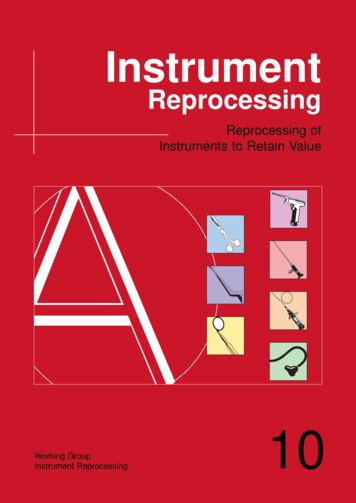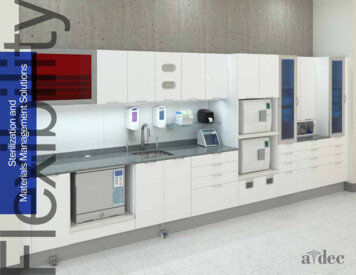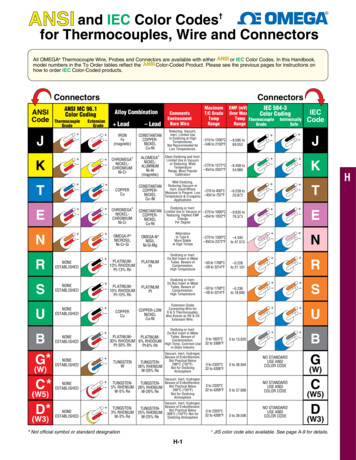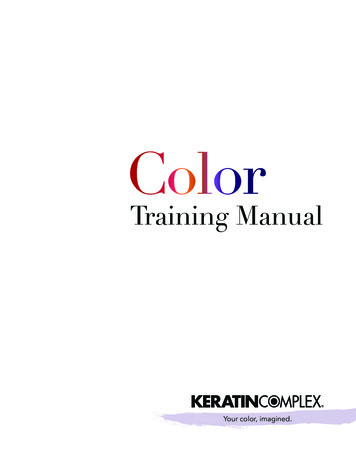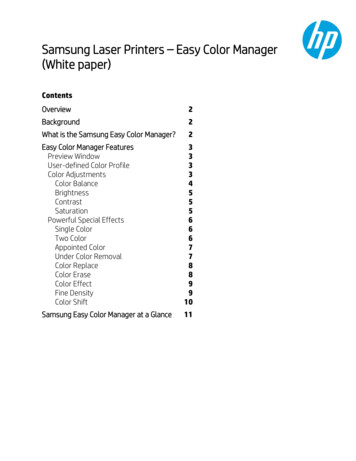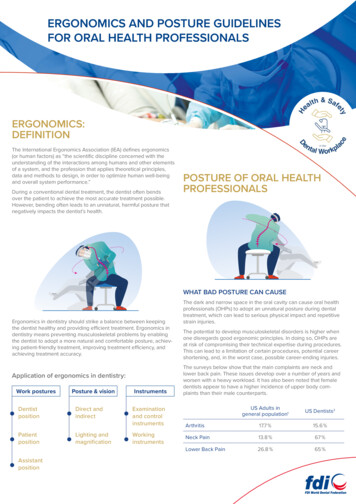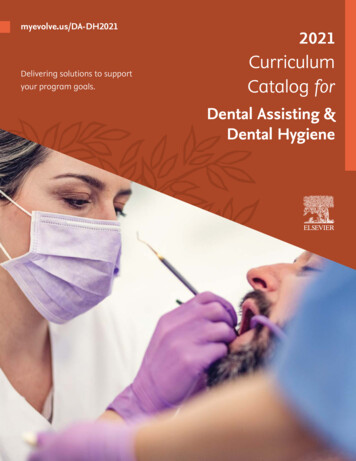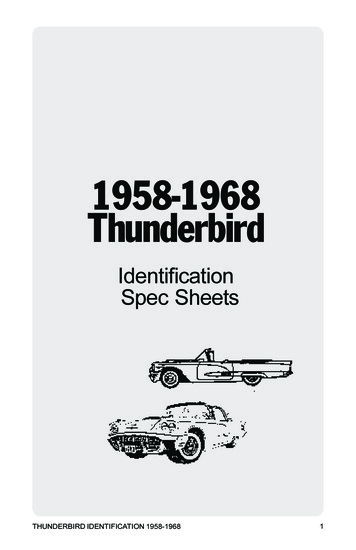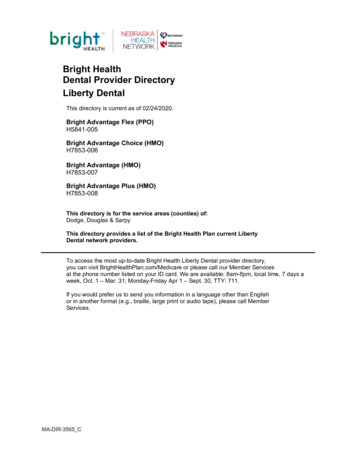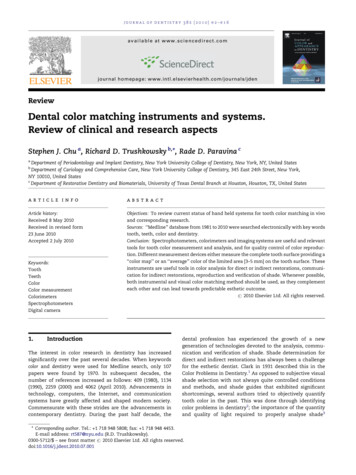
Transcription
journal of dentistry 38s (2010) e2–e16available at www.sciencedirect.comjournal homepage: tal color matching instruments and systems.Review of clinical and research aspectsStephen J. Chu a, Richard D. Trushkowsky b,*, Rade D. Paravina caDepartment of Periodontology and Implant Dentistry, New York University College of Dentistry, New York, NY, United StatesDepartment of Cariology and Comprehensive Care, New York University College of Dentistry, 345 East 24th Street, New York,NY 10010, United StatescDepartment of Restorative Dentistry and Biomaterials, University of Texas Dental Branch at Houston, Houston, TX, United Statesbarticle infoabstractArticle history:Objectives: To review current status of hand held systems for tooth color matching in vivoReceived 8 May 2010and corresponding research.Received in revised formSources: ‘‘Medline’’ database from 1981 to 2010 were searched electronically with key words23 June 2010tooth, teeth, color and dentistry.Accepted 2 July 2010Conclusion: Spectrophotometers, colorimeters and imaging systems are useful and relevanttools for tooth color measurement and analysis, and for quality control of color reproduction. Different measurement devices either measure the complete tooth surface providing aKeywords:‘‘color map’’ or an ‘‘average’’ color of the limited area [3–5 mm] on the tooth surface. TheseToothinstruments are useful tools in color analysis for direct or indirect restorations, communi-Teethcation for indirect restorations, reproduction and verification of shade. Whenever possible,Colorboth instrumental and visual color matching method should be used, as they complementColor measurementeach other and can lead towards predictable esthetic outcome.# 2010 Elsevier Ltd. All rights reserved.ColorimetersSpectrophotometersDigital camera1.IntroductionThe interest in color research in dentistry has increasedsignificantly over the past several decades. When keywordscolor and dentistry were used for Medline search, only 107papers were found by 1970. In subsequent decades, thenumber of references increased as follows: 409 (1980), 1134(1990), 2259 (2000) and 4062 (April 2010). Advancements intechnology, computers, the Internet, and communicationsystems have greatly affected and shaped modern society.Commensurate with these strides are the advancements incontemporary dentistry. During the past half decade, thedental profession has experienced the growth of a newgeneration of technologies devoted to the analysis, communication and verification of shade. Shade determination fordirect and indirect restorations has always been a challengefor the esthetic dentist. Clark in 1931 described this in theColor Problems in Dentistry.1 As opposed to subjective visualshade selection with not always quite controlled conditionsand methods, and shade guides that exhibited significantshortcomings, several authors tried to objectively quantifytooth color in the past. This was done through identifyingcolor problems in dentistry2; the importance of the quantityand quality of light required to properly analyse shade3* Corresponding author. Tel.: 1 718 948 5808; fax: 1 718 948 4453.E-mail address: rt587@nyu.edu (R.D. Trushkowsky).0300-5712/ – see front matter # 2010 Elsevier Ltd. All rights reserved.doi:10.1016/j.jdent.2010.07.001
e3journal of dentistry 38s (2010) e2–e16through studying correlation between extracted teeth andshade guides4 or the development of the early shademeasuring instruments and shade guides.5The late 1990s marked the birth of a new industryin dentistry, commercially available instrument-basedcolor measurement systems, with the development of theShadeScan system (Cortex Machina, Montreal, Canada).6 Thiswas the first effort toward a shade analysis system forcomplete tooth surface measurement. Prior literature published by several authors described limited area measurementinstruments, with an optical diameter of 3–5 mm, in theanalysis of shade.7–9 Another study evaluated clinical application of the ShadeScan prototype which employed digitalcamera technology, in a case report comparing visual vs.instrument-based shade information in the restoration of asingle maxillary central incisor.10Today’s shade-matching technologies have been developed in an effort to increase the success of color matching,communication, reproduction and verification in clinicaldentistry, and, ultimately, to increase the efficiency of estheticrestorative work within any practice. The aim of this paper isto provide a comprehensive review of the current state ofshade-matching technologies and instrumentation, and theirclinical and research application.2.RationaleDental shade-matching instruments have been brought tomarket to reduce or overcome imperfections and inconsistencies of traditional shade matching. The most commonlyused shade-matching method is the visual method, whilstVitapan Classical (Vita Zahnfabrik, Bad Säckingen, Germany)and its derivations are probably the most commonly usedshade guides. The colored tabs of distinctive shades organizethe empiric-based Vita chart.11–14 In addition, unequivocalfindings were reported on color consistency amongst shadeguides from the same manufacturer.15,16 Introduction ofevidence-based Vitapan 3D-Master shade guides, Toothguide,Bleachedguide and particularly Linearguide by the samemanufacturer correspond to color of human teeth andtherefore increase chances for successful shade matching.17,18Historically, assessing shade visually has been characterized by several innate difficulties: metamerism, suboptimalcolor matching conditions, tools and method as well as thereceiver’s age fatigue, mood and drugs/medications.19 Despitethese difficulties, the human eye can discern very smalldifferences in color. However, the ability to communicate thedegree and nature of these differences is lacking.The final color of an all-ceramic restoration is a merging ofthe underlying tooth structure or core and the ceramicmaterial. The color of the final restoration cannot match theshade selected from a shade guide unless this modification istaken into account. Therefore, a stump or base toothpreparation shade needs to be obtained and transmitted tothe technician.203.OverviewInstruments for clinical shade-matching encompass spectrophotometers, colorimeters and imaging systems. As with anydevice, benefits and limitations exist, and the clinician mustconsider how the technology relates to expectations andneeds. Intra-oral color measuring devices have been designedto primarily fit the needs of clinical dentistry, such asinformation on the corresponding shade tabs, tooth translucency, or information associated with color communication,reproduction and verification. This, together with pricelimitation dictated by the dental market, resulted in havingscientific aspects, such as providing reflectance values or colorformulation, less emphasized. Another significant differencecompared to other, non-dental applications, are opticalproperties of human teeth—they are small, curved, multilayered, translucent and exhibit color transitions in alldirections (gingival to incisal, mesial to distal and labial tolingual). This is why the accurate repositioning (measurementof the same area) is frequently of critical importance for eitherclinical and research use of dental color matching devices. Thelist of instruments and software for in vivo color matching andtheir properties is given in Table 1.21In addition to the instruments listed in Table 1, there arenumerous dental color matching products that are presentlywithdrawn from the market, of limited availability, orundergoing major redesigning. The list includes Chromascan(Sterngold, Stamford, CT, USA), Dental Color Analyzer (WolfIndustries, Vancouver, Canada), Identacolor II (Identa, Holbaek, Denmark), Digital Shade Guide DSG4 (A. Reith, Schorndorf, Germany), Ikam (Metalor Technologies, Attleboro, MA,USA), ShadeEye NCC Chroma Meter (Shofu Dental, Menlo Park,CA, USA), Beyond Insight Shade Taking Device (Beyond Dental& Health, Beijing, China), Shadescan (Cynovad, Montreal,Canada) and Vita Easyshade (Vita Zahnfabrik, Bad Säckingen,Germany).Table 1 – Instruments and software for color matching in dentistry: types, measurement area and relative cost ( 1000– 7500).21.ProductClearMatchCrystalEyeEasyshade CompactShade-XShadeVisionSpectroShade MicroManufacturerDevice typeMeasurement areaClarity Dental, Salt Lake City, UTOlympus America, Center Valley, PAVident, Brea, CAX-Rite, Grandville, MIX-Rite, Grandville, MIMHT, Niederhasli, SwitzerlandSoftware, digital image analysisImaging rImaging colorimeterImaging SpectrophotometerComplete tooth imageComplete tooth image5-mm probe diameter3-mm probe diameterComplete tooth imageComplete tooth imageRelative costLowHighLowLowModerateModerate
e4journal of dentistry 38s (2010) e2–e164.Characteristics and clinical application4.2.4.1.SpectrophotometersColorimeters measure tristimulus values and filter light in red,green and blue areas of the visible spectrum. Colorimeters arenot registering spectral reflectance and can be less accuratethan spectrophotometers (aging of the filters can additionallyaffect accuracy).31 ShadeVision (X-Rite, Grandville, MI) is animaging colorimeter. Complete tooth image is providedthrough the use of three separate databases: for gingival,middle and incisal third. Virtual try-in feature enables virtualtesting of color reproduction during fabrication.32Spectrophotometers are amongst the most accurate, usefuland flexible instruments for overall color matching and colormatching in dentistry.22 They measure the amount of lightenergy reflected from an object at 1–25 nm intervals along thevisible spectrum.23,24 A spectrophotometer contains a sourceof optical radiation, a means of dispersing light, an opticalsystem for measuring, a detector and a means of convertinglight obtained to a signal that can be analysed. The dataobtained from spectrophotometers must be manipulated andtranslated into a form useful for dental professionals. Themeasurements obtained by the instruments are frequentlykeyed to dental shade guides and converted to shade tabequivivalent.25 Compared with observations by the humaneye, or conventional techniques, it was found that spectrophotometers offered a 33% increase in accuracy and a moreobjective match in 93.3% of cases.26Crystaleye (Olympus, Tokyo, Japan) combines the benefits ofa traditional spectrophotometer with digital photography.Through the development of optical and image processingtechnology, this product allows the practitioner to matchtooth shade and color more accurately and simply comparedwith the traditional spectrophotometer.27The significant benefit of this system is that ‘virtual shadetabs’ in the computers database can be cross-referenced andsuperimposed visually onto the natural tooth image to bematched giving the technician the ability to visualize thecorrect shade tabs. The digital image produced by theCrystaleye uses a 7-band LED light source, which results ina more precise depiction of color than the conventionalsystems used with digital cameras. Moreover, the imageproduced by the Crystaleye is taken from inside the oral cavityand consequently is devoid of the external light that can causediscrepancies.Vita Easyshade Compact (Vita Zahnfabrik, Bad Säckingen,Germany) is cordless, small, portable, cost efficient, batteryoperated, contact-type spectrophotometer that providesenough shade information to help aid in the color analysisprocess. Different measurement modes are possible withEasyshade Compact: tooth single mode, tooth area mode(cervical, middle and incisal shades), restoration colorverification (includes lightness, chroma and hue comparison)and shade tab mode (practice/training mode).28Shade-X (X-Rite, Grandville, MI) is also compact andcordless ‘‘spot’’ measurement’’ spectrophotometer with 3mm probe diameter, and keyed to the majority of popularshade guides. Shade-X have two databases to match the colorof the dentin (more opaque) and the incisal tooth regions(more translucent).29SpectroShade Micro (MHT Optic Research, Niederhasli,Switzerland) is an imaging spectrophotometer. It uses adigital camera/LED spectrophotometer combination. It hasan internal computer with the analytical software. The toothpositioning guidance system, shown on the LCD touch screen,is used during color measurement. Images and spectral datacan be saved on the internal memory and transferred to acomputer.304.3.ColorimetersDigital cameras and imaging systemsDigital Cameras. Most consumer video or digital still camerasacquire red, green and blue image information that is utilizedto create a color image. The RGB color model is an additivemodel in which red, green and blue light are added together invarious ways to reproduce a broad array of colors. Digitalcameras represent the most basic approach to electronicshade taking, still requiring a certain degree of subjectiveshade selection with the human eye.33 Various approacheshave been used to translate this data into useful dental colorinformation.ClearMatch (Smart Technology, Hood River, OR) is asoftware system that uses high-resolution digital imagesand compares shades over the entire tooth with knownreference shades.30 Similar to the software associated withcolor measuring devices, ClearMatch contains the colordatabase of industry-standard shade guides.344.4.Interpretation and application of shade analysis dataComplete tooth surface measurement [CTSM] devices give acolor map of the gingival, body and incisal shades for thefabrication of direct or indirect restorations. These systemsgive a virtual shade overlay of the proposed tab onto the digitalimage on the computer screen of the tooth measured for visualreference and assessment by the clinician and/or technician.CTSM spectrophotometers, such as Crystaleye and SpectroShade, provide shade tab designation and the respective DE*values compared to shade tab values in the memory. However,these mappings are two dimensional and they do notnecessarily take into account the shape, texture, thicknessof the restoration, type of abutment and different corematerial (metal or ceramic).35 In addition, they ‘average out’color data over the complete tooth surface or larger definedareas which can lead to inaccurate shade information.Limited area measurement devices provide 3–5 mm diameter areas of the tooth being measured. Therefore severalareas of the tooth should be considered to obtain arepresentative evaluation of tooth shade. At a minimum, alimited area measurement of the gingival, body and incisalareas of the tooth [total of 3 measurements] should beassessed and recorded for the technician if an indirectrestoration is prescribed. It was found that decreasing thewindow size when examining extracted teeth with a spectrophotometer and spectroradiometer resulted in lower CIE L*a*b*values.36 Small-window tooth color measurement may causeedge loss of the light due to a tooth’s translucency.37
journal of dentistry 38s (2010) e2–e16Once the technology-based information is analysed, theinformation must be communicated to the technician forindirect restorations.38 The aforementioned instruments andtechnologies are predominantly intended for shade analysis,however, this information alone may be insufficient for thetechnician to adequately interpret the shade informationprovided. Subsequent reference photography is highly recommended for communication on tooth color. Digital photographs are an important adjunct to the laboratory technicianand together with the shade or ‘‘color map’’ should besufficient communication material to construct an acceptablerestoration.Clinicians and technicians are frequently located indifferent areas. A digital camera permits the transfer ofimages from the clinician to the technician. The best way toreference shade information is by using shade tabs tocommunicate shade.39 A systematic protocol to referencingshade information as well as changes in shade between tabs isrequired. Shades identified in the digital map are arranged bygingival (G), middle (M) and incisal third (I). The shade tabsshould be selected and photographs should be taken with eachtab in its proper orientation in reference to the tooth.Camera and light settings and image format must be keptconstant at all times for consistent shade color communication. In addition to the three basic shade tabs representing therespective G, M and I shades, two additional reference shadetab photographs should be included to graduate and calibrateshifts in hue, chroma and value between physical tabs visuallyin the laboratory, in the photographs and between the photos.One selected tab should be lighter in shade and one darker inshade in respect to the selected basic shades. The combinationof accurate digital shade analysis information coupled withstandardized reference shade communication photographycan ensure a predictable esthetic restorative outcome of thefinal direct or indirect restoration.Indirect restorations can and should be verified visuallyand with the instrument system in the laboratory prior tobeing returned to the clinician. This verification process canstreamline wasteful chair side time attributed to remakes dueto incorrect shade.40,41 Clinical excellence backed with soundcolor science and its appropriate interpretation can probablymake the critical difference between good to excellent.42Examples of color matching, interpretation and application ofshade analysis data are given in Figs. 1–6.5.ResearchBesides the clinical applications, dental color measuringinstruments and systems are increasingly used in research.The most frequent research topics associated with theseinstruments and systems are associated with evaluation ofmeasurement uncertainties, comparison between visual andinstrumental findings, visual color thresholds and evaluation oncolor compatibility, stability and interactions of human hardand soft oral tissues, head and neck tissues and dentalmaterials. Although non-dental, professional bench-top colormeasurement instruments were used in many research projectsin dentistry, this paper will focus mainly on these conductedusing hand held devices designed for dental application.5.1.e5Measurement uncertaintiesIn color science, evaluation of measurement uncertainties ofshade-matching instruments is performed through precisionand accuracy testing. The uncertainties associated withprecision are most frequently associated with random errors,whilst the uncertainties associated with accuracy usuallyoriginate from systematic errors. Precision is tested by evaluation of repeatability (same method, operator or instrument) andreproducibility (different method, operator and/or instrument).Based on time interval, we are talking about short term(measurements in succession), medium term (hours) and longterm measurements (weeks or longer). Based on the specimenmanipulation, measurement can be performed with- andwithout replacement.43 Evaluation of measurement uncertainties encompasses the use of referent instrument, preferablyprofessional, non-dental, color measuring instrument.37In a study that compared five dental color measuringdevices—ShadeScan, Easyshade, Ikam, IdentaColor II andShadeEye, five group A Classical tabs were in vitro measuredfive times by two operators, whilst 25 upper right centralincisors were measured in vivo by one operator. The bestprecision in vivo was recorded for Easyshade and Ikam, whilstperformance of the other instruments was better in vitro thanin vivo.12 In an another study, SpectroShade, ShadeVision,VITA Easyshade and ShadeScan were evaluated.31 Highreliability (reproducibility?) and variability in accuracy wasreported. One in vitro study found that repeatability andaccuracy of a dental color measuring instrument (ShadeScan)was influenced by shade guide systems used for testing.44When the precision of measurement of different tooth areaswas evaluated, the middle third of each labial tooth surfaceexhibited the most consistent resuts.45Dental color matching instruments also provide theinformation on best matching tabs from different shadeguides.25,46,47 This application-specific color information isalso of importance and therefore requires proper attention ofdental researches. When VITA EasyShade and ShadeEye NCCwere tested on extracted human teeth, there were discrepancies in shade guide designations provided by the instruments. Higher inter-device agreement was recorded forVitapan Classical than for Vitapan 3D-Master.25Digital imaging systems are becoming increasingly popularin determining the color of teeth. Precision and accuracy ofthese systems are influenced by the quality of camera andimage processing method. Several studies reported that digitalcameras, may be reliable instruments for determining thecolor of teeth and gingiva when combined with the appropriate calibration protocols.48–54Clinical imaging and conventional image processingmethods such as Adobe Photoshop and Corel Photo-Paintare suitable for many purposes in dentistry: lab communication, documentation, patient education and others. However,scientific imaging,55 appropriate methods of data processingand color science terminology is preferred in dental research.This, together with lack of the referent instrument (theinstrument that has already been validated, not necessaryby the same authors), diminished the validity of somestudies on precision and accuracy of dental color matchinginstruments.
e6journal of dentistry 38s (2010) e2–e16Fig. 1 – Clinical application of CrystalEye spectrophotometer (Courtesy Dr. Shigemi Nagai). (a) Crystaleye captures thespectral image of the tooth, abutment, arch and full face image. (b) Laboratory report can be sent to the lab as a quick colornote. (c) Color analysis of the ceramic crown (after 1st bake try-in) placed on the abutment. Excellent color match wasconfirmed in the cervical and body areas. Minor modification may be required in the incisal area to increase the value andyellowness. (d) Color difference DEs obtained in all 3 areas are considered to be excellent color match. L* value mapindicates indistinguishable value distribution on #8 and #9.
journal of dentistry 38s (2010) e2–e16e7Fig. 1. (Continued ).5.2.Comparison between visual and instrumentalfindingsWhen the first dental color measuring instruments appeared,they exhibited slightly better accuracy compared to visualfindings that were described as inconsistent.56 Since that time,the modernization of both visual and instrumental means forcolor matching in dentistry occurred.17,57 More recently, betterresults were reported with dental spectrophotometer thanusing the visual method in approximately 47% of the cases,58which is in accordance with independent studies thatdocumented the supremacy of spectrophotometric colormatching compared to visual shade assessment.27,59 Anotherpaper reported that the performance of Easyshade wascomparable or better than that of dentists, whilst theagreement between visual and instrumental findings wasqualified as good to very good.60 In another paper, it was foundthat the agreement amongst the observer groups wassignificantly better than that of each device and that colormatching instruments did not reflect human perception.61It was found that consensus amongst observers led tobetter shade-matching results with some shade guides,compared to results of individual observers,62 and thatintraexaminer shade-matching agreement was mainly acceptable.63 Significantly higher visual-instrumental agreement was recorded for experienced dentists (compared todental students and non-dental observers), regardless ofshade guides and lighting conditions.64The comparison between visual and instrumental findingsis a very attractive topic as it reveals pros and cons of bothmethods. Visual color matching is subjective and influencedby variety of factors. However, this method is not inferior andshould not be underrated. Actually, the all ‘‘objective’’ colormeasuring instruments have been developed based on thevisual response of the ‘‘standard observer’’ and they are goodonly if they match that response. In addition, the numericallysmallest DE* value does not necessarily correspond to the bestmatch because of the uneven eye sensitivity to hue, value andchroma differences. Therefore, the answer whether to usevisual or instrumental method for color matching in dentistryis: whenever if possible, use both, as they complement eachother and can lead towards predictable esthetic outcome.39–415.3.Evaluation of visual color thresholdsPerceptibility and acceptability visual thresholds can bequantified only by combining visual and instrumental colormeasurement methods. Although majority of studies usedprofessional (non-dental) color measuring devices in threshold evaluation, this topic is of exceptional importance ininterpretation of color differences in clinical dentistry anddental research.When the color difference between compared objects canbe seen by 50% of observers (the other 50% will notice nodifference), we are talking about the 50:50% perceptibilitythreshold.65 When the color difference is considered acceptable 50% of observers (the other 50% would consider itunacceptable), this corresponds to 50:50% acceptabilitythreshold. A color match in dentistry is a color difference ator below the former threshold, an acceptable color match is acolor difference at or below the later one.65In dental literature, it is frequently interpreted that a DE* of1 is the 50:50 perceptibility threshold under controlledconditions (50% of observers will notice the color differenceand 50% will see no difference between compared objects),66whereas a DE* of 2.767 and 3.368 were found to be 50:50acceptability thresholds (50% of observers will accept therestoration and 50% will replace it because of color mismatch).
e8journal of dentistry 38s (2010) e2–e16Fig. 2 – Clinical application of EasyShade Compact spectrophotometer. (a) Instrument calibration. (b) Color measurement. (c)Color difference metric values as compared to the corresponding Vitapan Classical shade. (d) Color coordinate values andthe corresponding Vitapan 3D-Master shade.Several other studies, more or less controlled, reported thevariability of findings on visual color thresholds.57,69–71 This, inaddition to the introduction of new color difference formulae(CIEDE2000), suggests systematic approach and standardization of methods.5.4.shade guides exhibit moderate to pronounced discrepancywith results recorded for natural teeth. This discrepancyhas been quantified by calculation of coverage error, themean value of the minimal color differences amongstColor compatibilityColor compatibility studies encompass comparisonsamongst teeth, shade guides and dental materials. Evaluation of color of natural teeth is important for clinical dentistrysince knowledge on color ranges and color distribution ofnatural teeth can provide guidelines for designing of dentalmaterials that will enable better and easier match to naturalteeth.13,72 Databases encompassing spectral properties ofteeth, regardless whether created using dental or non-dentalcolor measuring devices, are of particular validity.73 Twoindependent studies, both performed using Vita Easyshade,reported almost the same color coordinate ranges of naturalteeth: L* 55.5–89.674 and L* 58.7–88.775; a* 4.2–7.374 anda* 3.6–7.075, and b* 3.6–38.974 and b* 3.7–37.3.75 CurrentFig. 3 – Clinical application of Shade-X spectrophotometer.
journal of dentistry 38s (2010) e2–e16e9Fig. 4 – Clinical application of ShadeVision colorimeter. (a) The fractured veneer restoration on tooth #8 is to be replaced witha new veneer restoration. (b) The ShadeVision color mapping for tooth #9 to be matched with gingival, body and incisalshade reference tabs. (c) Veneer preparation tooth #8. It is important that an even thickness of tooth reduced is performed toinsure color control of ceramic layering for predictable shade matching of the restoration. (d) Insertion of veneer restorationtooth #8 [Venus porcelain, Heraeus, Hanau, Germany] which matches the contralateral tooth satisfactorily and predictablywithout a remake.each tab in the shade guide and the database of humanteeth.17,73–76Although teeth exhibit color transitions in all directions,the correlation between colors of different regions on thelabial tooth surface has been recorded. This study, performedusing digital camera, suggested that color of a missing part of atooth can be determined using the color of existing areas.77The same team reported color correlation between maxillaryincisors and canines, which may influence color matching ofmissing teeth.78As far as the compatibility amongst materials is concerned, different comparisons have been performed. AnEasyshade comparison between Vitapan Classical shadeguide and four different veneering porcelain systems formetal ceramic restorations, revealed that differences wereshade-dependent: A2 porcelain disks exhibited better matchto corresponding VITA shade, followed by A3 and A3.5disks.79 The same instrument was used to test the ability ofa ceramic system to correctly reproduce the shade selectedusing two shade guides. Toothguide 3D-Master outperformed VITA Classical.80 When the quality of color matchof different shade guides and corresponding porcelains wasevaluated, the highest percentage of clinically acceptablematches was recorded for Toothguide 3-D Master/Omega900 combination.81 A study, conducted using Easyshade,reported that evaluated resin composites exhibited poormatch compared to target Vitapan Classical tabs of the sameshade designations.82 Similar conclusions were derivedwhen various composites of corresponding shades werecompared with a shade guide using a non-dental colorimeter,83 and with each other using a bench-top spectrophotome
Review Dental color matching instruments and systems. Review of clinical and research aspects Stephen J. Chua, Richard D. Trushkowskyb,*, Rade D. Paravinac a Department of Periodontology and Implant Dentistry, New York University College of Dentistry, New York, NY, United States b Department o
